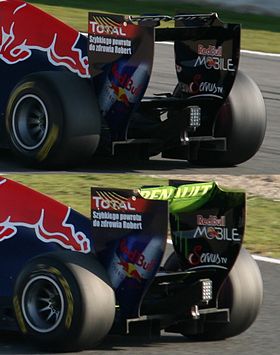Drag Reduction System

The Drag Reduction System ( DRS for short , German: system for reducing air resistance ), colloquially often referred to as the movable rear wing , is a technology that has been used since the 2011 Formula 1 World Championship , since the 2013 DTM season and since 2012 in the Formula Renault 3.5 is used. In Formula 1, this technique leads to frequent overtaking maneuvers. A part of the rear wing is hydraulically flattened to enable lower air resistance on a straight line and a higher top speed.
Formula 1 regulations
The system may only be used by drivers who are within one second of the vehicle in front at a measuring point on the route previously determined by the FIA . The driver can then activate the system in a defined area of the route in order to be able to overtake the competitor in front - usually on a long straight - thanks to the higher speed. The system is automatically deactivated as soon as the driver presses the brake pedal. For safety reasons, the use of the system is not permitted on wet roads. In the race, use after the start or each safety car phase is only permitted after two laps have been completed.
Since the Canadian Grand Prix in 2011 , the FIA has been able to define up to two DRS zones on suitable routes.
Until 2012 , the use of the DRS in all training sessions and qualifying was permitted without restriction. Since the 2013 season , it has only been permitted to use the system in all sessions in the DRS zone.
DTM regulations
The system may always be used by the driver behind if he is less than 2 seconds away from the vehicle ahead at the start / finish point. When using the safety car and three laps thereafter, DRS may not be used. It will then be released again by the race management. In addition, it was allowed to be used three laps after the start of the race and was not allowed to be used before the end of the race. Since the 2014 DTM season , DRS can be used until the end of the race.
Functionality and regulations in Formula Renault 3.5
The system works differently in Formula Renault than in DTM and Formula 1. While in the two other series the wing is flattened so that there is less contact pressure, the wing is set in the other direction, i.e. steeply. This creates an air jam (called "airstall" in specialist circles), which makes the rear wing inoperable. The rules for using the system are also different in this series. Instead of referring the permission to use the DRS to specific zones and the distance to the vehicle in front, a driver in the Formula Renault 3.5 can freely choose the location on the track and the time when it should be used. The only limit is the duration of use. This means that the use of the system is usually limited to 500 seconds.
Effects
The use of the DRS gives the vehicle a speed gain of around 15 km / h. In interaction with the slipstream of the vehicle in front and the use of stored energy in the ERS hybrid drive , the DRS makes overtaking at the end of long straights easier. However, the opponent can compensate for this advantage through skillful use of the ERS.
The introduction of DRS initially led to a significant increase in the number of overtaking maneuvers in Formula 1. However, after new aerodynamic rules were introduced for the 2017 Formula 1 season, this number fell significantly again; The DRS also lost part of its effectiveness in this context.
criticism
During the test drives before the start of the 2011 Formula 1 season, some drivers criticized the fact that the use of the DRS led to increased workload in the cockpit, as the driver had to operate additional buttons and this could pose a safety risk.
In addition, there is criticism from various quarters that this system makes overtaking too easy. DRS is an unfair advantage for the driver driving behind and the overtaking maneuvers carried out with it are "artificial".
Individual evidence
- ↑ a b "DRS: The indirect free kick of Formula 1". Motorsport-Total.com, April 16, 2011, accessed April 16, 2014 .
- ↑ “FIA bans wet moveable wings use” (Autosport.com on March 25, 2011)
- ↑ "FIA strongly restricts DRS use." (Motorsport-Magazin.com on February 9, 2013)
- ↑ Stefan Ziegler: "DTM 2014: This is new". Motorsport-Total.com, April 14, 2014, accessed April 16, 2014 .
- ↑ “Adjustable wing to aid passing in 2011” (Autosport.com on June 23, 2010)
- ↑ How DRS falsifies the Formula 1 overtaking records , motorsport-total.com of January 3, 2017; Accessed March 27, 2018
- ↑ a b Lack of overtaking action: FIA does not want any larger DRS zones , motorsport-total.com from May 1, 2017; Accessed March 27, 2018
- ↑ 100th place on the podium for racing team , orf.at ; Accessed March 27, 2018
- ↑ Alain Prost wishes to move away from V6 engines and DRS , motorsport-total.com from April 21, 2017; Accessed March 27, 2018
- ↑ Ross Brown warns: overtaking problem cannot be solved before 2021 , motorsport-total.com of March 27, 2018; Accessed March 28, 2018
- ↑ "DRS is insane!": Nigel Mansell waddles Formula 1 , motorsport-total.com from October 22, 2015; Accessed March 27, 2018
- ↑ Montoya: Drivers Unlearn Overtaking , spox.com, August 7, 2013; Accessed March 27, 2018
- ↑ This is how Liberty wants to solve the overtaking problem: Active suspension as an overtaking helper , auto-motor-und-sport.de of April 12, 2017; Accessed March 27, 2018
- ↑ Artificial overtaking nonsense: Solution wanted for DRS , Speedweek from March 5, 2017; Accessed March 27, 2018